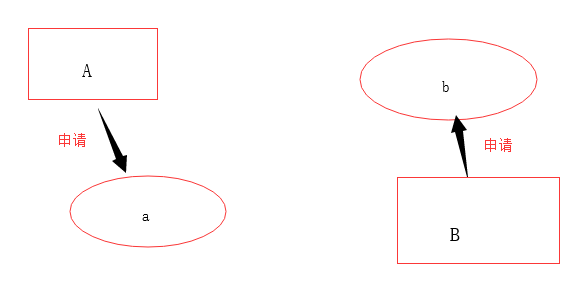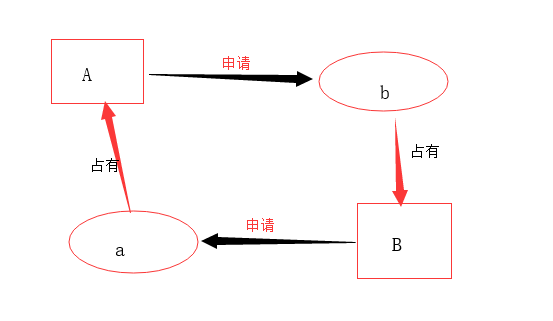一、python多线程
对于I/O操作的时候,进程与线程的性能差别不大,甚至由于线程更轻量级,性能更高。这里的I/O包括网络I/O和文件I/O
1、实例
假如利用socket发送http请求,也就是网络I/O。爬取列表网页中的写href链接,然后获取href链接之后,在爬去链接的网页详情。
如果不适用多线程的话,程序串行的执行,结果就是要先等待列表网页获取所有的href的链接之后,才可以逐个的爬去href链接所指的网页详情,这就使得等待时间很长。
如果使用多线程编程,线程A执行第一个列表网页程序,遇到I/O操作,GIL释放,当获取到第一个href链接之后,线程B就自动的去获取href链接所指的网页详情。
2、多线程实现
使用sleep模拟网络I/IO
# test3.pyimport timeimport threadingdef get_detail_html(url):
print("get detail html started")
time.sleep(2)
print("get detail html end")def get_detail_url(url):
print("get detail url started")
time.sleep(4)
print("get detail url end")if __name__ == "__main__": # 函数方法 arg 为函数参数
thread1 = threading.Thread(target=get_detail_html, args=("",))
thread2 = threading.Thread(target=get_detail_url, args=("",))
start_time = time.time() # 子线程1,2开始
thread1.start()
thread2.start() print ("last time: {}".format(time.time()-start_time))# 执行结果get detail html started
get detail url started
last time: 0.0019958019256591797 # 忽略为0get detail html end
get detail url end按照上面线程并行执行的逻辑应该是打印时间为2秒,但是结果却为0。
任何进程默认就会启动一个线程,该线程称为主线程,主线程又可以启动新的线程。上面的thread1与thread2就是主线程启动的两个新的线程,那么在两个子线程启动之后,主线程中其余的程序段print函数也在并行执行,所以时间为0。当两个子线程运行完毕之后,主线程退出,进程关闭,程序运行结束。才会打印出get detail html end,get detail url end。
3、守护线程
那么如何使得主线程退出的时候子线程也退出。或者说,主线程推出的时候kill掉子线程?
<1>、将子线程设置成守护线程
# test4.pyimport timeimport threadingdef get_detail_html(url):
print("get detail html started")
time.sleep(2)
print("get detail html end")def get_detail_url(url):
print("get detail url started")
time.sleep(4)
print("get detail url end")if __name__ == "__main__": # 函数方法 arg 为函数参数
thread1 = threading.Thread(target=get_detail_html, args=("",))
thread2 = threading.Thread(target=get_detail_url, args=("",))
thread1.setDaemon(True)
thread2.setDaemon(True) # 将两个线程设置为守护线程,即主线程退出,这两个子线程也退出,kill
start_time = time.time() # 子程开始
thread1.start()
thread2.start() #当主线程退出的时候, 子线程kill掉
print ("last time: {}".format(time.time()-start_time))# 输出get detail html started
get detail url started
last time: 0.0将两个线程设置为守护线程,即主线程退出,这两个守护线程也退出。打印结果中执行到print之后直接程序结束。
由于两个线程的时间不相同,那么两者有什么区别呢
<2>、先将thread1设置为守护线程
# test5.pyimport timeimport threadingdef get_detail_html(url):
print("get detail html started")
time.sleep(2)
print("get detail html end")def get_detail_url(url):
print("get detail url started")
time.sleep(4)
print("get detail url end")if __name__ == "__main__": # 函数方法 arg 为函数参数
thread1 = threading.Thread(target=get_detail_html, args=("",))
thread2 = threading.Thread(target=get_detail_url, args=("",))
thread1.setDaemon(True) # 只将thread设置为守护线程
# thread2.setDaemon(True)
start_time = time.time()
thread1.start()
thread2.start() #当主线程退出的时候, 子线程kill掉
print ("last time: {}".format(time.time()-start_time))# 结果 get detail html started
get detail url started
last time: 0.000997781753540039get detail html end
get detail url end只将thread1设置为守护线程之后,由于thread2的sleep时间为4秒,所以主线程仍会等待thread2执行结束之后才退出,而thread1由于时间为2秒,所以也会打印。
<3>、先将thread2设置为守护线程
# test6.pyimport timeimport threadingdef get_detail_html(url):
print("get detail html started")
time.sleep(2)
print("get detail html end")def get_detail_url(url):
print("get detail url started")
time.sleep(4)
print("get detail url end")if __name__ == "__main__": # 函数方法 arg 为函数参数
thread1 = threading.Thread(target=get_detail_html, args=("",))
thread2 = threading.Thread(target=get_detail_url, args=("",)) # thread1.setDaemon(True)
thread2.setDaemon(True)
start_time = time.time()
thread1.start()
thread2.start() print ("last time: {}".format(time.time()-start_time))# 输出get detail html started
get detail url started
last time: 0.0029969215393066406get detail html end由于只将thread2设置为守护线程,print函数执行结束的时候会首先kill掉thread2线程。但是由于thread1线程还未结束,程序仍会等待两秒输出get detail html end才结束。
4、线程阻塞
上面说了如何在主线程结束的时候,直接kill掉子线程。那么如何使子线程执行结束才执行主线程,就是阻塞主进程。
<1>、结束两个子线程
# test7.pyimport timeimport threadingdef get_detail_html(url):
print("get detail html started")
time.sleep(2)
print("get detail html end")def get_detail_url(url):
print("get detail url started")
time.sleep(4)
print("get detail url end")if __name__ == "__main__": # 函数方法 arg 为函数参数
thread1 = threading.Thread(target=get_detail_html, args=("",))
thread2 = threading.Thread(target=get_detail_url, args=("",))
start_time = time.time() # 子线程开始
thread1.start()
thread2.start() # 子线程程结束
thread1.join()
thread2.join() #当主线程退出的时候, 子线程kill掉
print ("last time: {}".format(time.time()-start_time))#输出get detail html started
get detail url started
get detail html end
get detail url end
last time: 4.001712799072266由于调用了两个thread的join方法,主线程阻塞,当子线程结束之后,print函数执行后主线程退出,程序结束。
<2>、结束thread1线程
# test8.pyimport timeimport threadingdef get_detail_html(url):
print("get detail html started")
time.sleep(2)
print("get detail html end")def get_detail_url(url):
print("get detail url started")
time.sleep(4)
print("get detail url end")if __name__ == "__main__": # 函数方法 arg 为函数参数
thread1 = threading.Thread(target=get_detail_html, args=("",))
thread2 = threading.Thread(target=get_detail_url, args=("",))
start_time = time.time() # 子线程开始
thread1.start()
thread2.start() # 1线程程结束
thread1.join() # thread2.join()
#当主线程退出的时候, 子线程kill掉
print ("last time: {}".format(time.time()-start_time))# 输出get detail html started
get detail url started
get detail html end
last time: 2.001251220703125get detail url end由于调用了thread1的join方法,阻塞主线程,thread1直接结束之后print打印时间,但是对另一个线程没有影响。所以在打印last time: 2.001251220703125时间,等待两秒打印get detail url end,主线程才会退出。
<3>、结束thread2线程
# test9.pyimport timeimport threadingdef get_detail_html(url):
print("get detail html started")
time.sleep(2)
print("get detail html end")def get_detail_url(url):
print("get detail url started")
time.sleep(4)
print("get detail url end")if __name__ == "__main__": # 函数方法 arg 为函数参数
thread1 = threading.Thread(target=get_detail_html, args=("",))
thread2 = threading.Thread(target=get_detail_url, args=("",))
start_time = time.time() # 子线程开始
thread1.start()
thread2.start() # 2线程程结束
# thread1.join()
thread2.join() #当主线程退出的时候, 子线程kill掉
print ("last time: {}".format(time.time()-start_time))# 输出get detail html started
get detail url started
get detail html end
get detail url end
last time: 4.002287864685059由于thread2线程的sleep的时间为4秒,期间thread1已经执行完毕,所以打印时间为4秒。
5、Thread类继承式创建
同样的也可以使用类继承的方法创建线程实例,效果一样的
# test10.pyimport timeimport threadingclass GetDetailHtml(threading.Thread):
def __init__(self, name):
super().__init__(name=name) def run(self):
print("get detail html started")
time.sleep(2)
print("get detail html end")class GetDetailUrl(threading.Thread):
def __init__(self, name):
super().__init__(name=name) def run(self):
print("get detail url started")
time.sleep(4)
print("get detail url end")if __name__ == "__main__": # 类继承方法
thread1 = GetDetailHtml("get_detail_html")
thread2 = GetDetailUrl("get_detail_url")
start_time = time.time() # 子线程开始
thread1.start()
thread2.start() # 子线程程结束
thread1.join()
thread2.join() #当主线程退出的时候, 子线程kill掉
print ("last time: {}".format(time.time()-start_time))二、线程通信
1、共享变量通信
共享变量通信,是线程间通信最简单的方式,但也是最容易出问题的方式。以上面爬去页面和网页链接的实例进行扩展。在上面的实例中,因为要解决请求列表页面的时候网络时延问题,引入了多线程并行,边爬去列表页获取href,再爬取href指向的想起那个页面,下面将爬去的页面存入列表实现。
# test11.pyimport threadingimport time
detail_url_list = [] # 存储着爬取下来的href链接def get_detail_html(detail_url_list): # 参数这里作为对全局变量的引用
while True: # 使用while语句使得线程持续爬去
if len(detail_url_list):
url = detail_url_list.pop()
print('get detail html start')
time.sleep(2)
print('get detail html end')def get_detail_url(detail_url_list):
while True: # 使用while语句使得线程持续爬取
print('get detail url start')
time.sleep(4) for i in range(20):
detail_url_list.append('http://www.xxxx.com/{}.html'.format(i))
print('get detail end')if __name__ == "__main__":
thread_detail_url = threading.Thread(target=get_detail_url, args=(detail_url_list,)) for i in range(10): # 为了模拟多个线程并发,这里创建了十个子线程
html_thread = threading.Thread(target=get_detail_html, args=(detail_url_list,))
html_thread.start()
start_time = time.time()
print("last time: {}".format(time.time() - start_time))但是上面问题也会很明显,在GIL的示例中,total变量由于变量共享的缘故,没有按照预期的执行。而在上面的爬虫实例中,detail_url_list作为全局共享变量,pop操作,append操作,多个线程共用资源,都不是线程安全的操作,会出现问题。所以就必须给变量加上锁,保持安全性。为了摆脱这种问题,使用消息队列通信
2、消息队列通信
消息队列通信也就是使用Queue这个类来表示变量,从而达到线程安全,由于Queue这个类内部封装了deque,也就是python中的双端队列。双端对列本身就是安全界别很高的一种类型,实现线程间的安全操作。
# test12.py#通过queue的方式进行线程间同步from queue import Queueimport timeimport threadingdef get_detail_html(queue):
#爬取文章详情页
while True:
url = queue.get()
print("get detail html started")
time.sleep(2)
print("get detail html end")def get_detail_url(queue):
# 爬取文章列表页
while True:
print("get detail url started")
time.sleep(4) for i in range(20):
queue.put("http://projectsedu.com/{id}".format(id=i))
print("get detail url end")if __name__ == "__main__":
detail_url_queue = Queue(maxsize=1000)
thread_detail_url = threading.Thread(target=get_detail_url, args=(detail_url_queue,)) for i in range(10):
html_thread = threading.Thread(target=get_detail_html, args=(detail_url_queue,))
html_thread.start()
start_time = time.time() # detail_url_queue.task_done()
detail_url_queue.join() #当主线程退出的时候, 子线程kill掉
print ("last time: {}".format(time.time()-start_time))使用了消息队列替代共享变量
Queue([maxsize]):创建共享的进程队列,Queue是多进程安全的队列,可以使用Queue实现多进程之间的数据传递。
q.put方法用以插入数据到队列中,put方法还有两个可选参数:blocked和timeout。如果blocked为True(默认值),并且timeout为正值,该方法会阻塞timeout指定的时间,直到该队列有剩余的空间。如果超时,会抛出Queue.Full异常。如果blocked为False,但该Queue已满,会立即抛出Queue.Full异常。没有参数时,q.put的个数大于队列数时,会一直阻塞住。
q.get方法可以从队列读取并且删除一个元素。同样,get方法有两个可选参数:blocked和timeout。如果blocked为True(默认值),并且timeout为正值,那么在等待时间内没有取到任何元素,会抛出Queue.Empty异常。如果blocked为False,有两种情况存在,如果Queue有一个值可用,则立即返回该值,否则,如果队列为空,则立即抛出Queue.Empty异常。没有参数时,q.get的个数大于队列数时,会一直阻塞住。
q.put_nowait()等价于q.put(block=False)队列满时再存也会抛异常
q.get_nowait()等价于q.get(block=False)队列为空取不出时会抛异常
q.task_done():使用者使用此方法发出信号,表示q.get()的返回项目已经被处理。如果调用此方法的次数大于从队列中删除项目的数量,将引发ValueError异常
q.join():生产者调用此方法进行阻塞,直到队列中所有的项目均被处理。阻塞将持续到队列中的每个项目均调用q.task_done()方法为止
三、线程同步
1、加锁
在上面的第一个GIL示例中,由于GIL释放的缘故,多个线程共享变量,导致total的值不像预期那样为0的问题发生,也就是如何线程同步。最简单的方式就是加锁。加锁使得一个线程在占用资源的时候,别的线程都必须等待,只有当这个线程主动释放资源的时候,其他线程才能使用资源,也就是资源占用互斥。这样就可要保证共享变量的安全性。
# test13.pyfrom threading import Lock#在同一个线程里面,可以连续调用多次acquire, 一定要注意acquire的次数要和release的次数相等total = 0lock = Lock()def add(): global lock global total for i in range(1000000): lock.acquire() # 加锁 total += 1 lock.release() # 释放锁def desc(): global total global lock for i in range(1000000): lock.acquire() # 加锁 total -= 1 lock.release() # 释放锁import threading thread1 = threading.Thread(target=add) thread2 = threading.Thread(target=desc) thread1.start() thread2.start() thread1.join() thread2.join() print(total)# 输出在等待了一段时间后输出00 # total的打印结果为0加锁的时候要保证加上锁执行完成之后,就要释放掉,不然会一直占用资源。
加锁的结果使得在执行total-=1或者total+=1的赋值语句的时候,该赋值语句对应的多条字节码指令执行完之后,才会其他进程执行修改total值。该线程占用了锁,所以其他线程不能修改total值,只有当该释放了锁,其他线程才能修改total值,不会造成修改共享变量的冲突。这是加锁的好处,那么代价也十分明显
加锁缺点:
加锁性能
死锁风险
补充:另外自己加的锁使用户级别的与GIL不同。
<1>、性能问题
本来的多线程,由于加锁的缘故,首先是阻止了多线程并发执行,包含锁的某段代码实际上只能以单线程模式执行。并且由于来回切换线程的缘故,程序性能变得低下
将test2.py改成如下
# test14.pytotal = 0def add():
global total for i in range(1000000):
total += 1def desc():
global total for i in range(1000000):
total -= 1import threadingimport time
start_time = time.time()
add()
desc()
print(total)
print("last time: {}".format(time.time() - start_time))# 输出0last time: 0.314816951751709这是简单的单线程程序,持续时间为0.3秒。没有使用thread多线程
下面使用threading多线程,并且加锁
# test15.pyfrom threading import Lock
total = 0lock = Lock()def add(): global lock
global total for i in range(1000000): lock.acquire()
total += 1
lock.release()def desc(): global total global lock
for i in range(1000000): lock.acquire()
total -= 1
lock.release()
import threading
import time
start_time = time.time()
thread1 = threading.Thread(target=add)
thread2 = threading.Thread(target=desc)
thread1.start()
thread2.start()
thread1.join()
thread2.join()
print(total)
print("last time: {}".format(time.time() - start_time))# 输出0last time: 5.062084674835205使用了多线程,为了保证共享变量的安全性操作,线程同步,加锁导致类似单线程,程序的运行时间达到了5秒钟。可见线程之间的切换十分浪费时间。所以说,CPython的GIL本意是用来保护所有全局的解释器和环境状态变量的,如果去掉GIL,就需要更多的更细粒度的锁对解释器的众多全局状态进行保护。做过测试将GIL去掉,加入更细粒度的锁。但是实践检测对单线程来说,性能更低。
<2>、死锁风险
来看下面例子
这里为了在一个线程中多次调用lock,使用可重入的锁Rlock对象
Lock与Rlock区别:
RLock允许在同一线程中被多次acquire。而Lock却不允许这种情况。注意:如果使用RLock,那么acquire和release必须成对出现,即调用了n次acquire,必须调用n次的release才能真正释放所占用的琐。
# test15.pyfrom threading import RLock # 可重入的锁total = 0lock = RLock()def add(): global lock
global total for i in range(1000000): lock.acquire() lock.acquire() # 这里加了两次锁
total += 1
lock.release()def desc(): global total global lock
for i in range(1000000): lock.acquire()
total -= 1
lock.release()
import threading
import time
start_time = time.time()
thread1 = threading.Thread(target=add)
thread2 = threading.Thread(target=desc)
thread1.start()
thread2.start()
thread1.join()
thread2.join()
print(total)
print("last time: {}".format(time.time() - start_time))由于在add函数中加了两次锁lock.acquire(),结果就是线程永远都不获释放掉共享变量。一直占用资源,其他的线程请求资源没有结果,多个线程挂起,既不能执行,也无法结束,一直处于等待状态,造成死锁,只能靠操作系统强制终止。最终程序也没有任何结果输出。
所以在同一个线程里面,可以连续调用多次acquire, 一定要注意acquire的次数要和release的次数相等
还有就是,线程的相互等待,假如内存中又两中资源a和b,而线程A(a,b)和线程B(a,b)都申请资源。
第一步
线程A先申请a资源,线程B先申请b资源,因此没有问题

第二步
由于a,b均已被A,B占用,并且A申请b,B申请b,在位获得新的资源的时候两者都不会退出对现有资源的占用,这就造成了两个线程相互等待,并且这种等待会一直持续下去,造成死锁。

2、线程复杂通信
在上面看到线程进行通信的时候需要加锁,如果如何使用锁进行线程的对话功能,例如
线程A:hello,你好啊
线程B:你好
线程A:吃饭了吗
线程B:吃过了,你呢
线程A:我也吃过了,咱们去搞PVM吧
线程B:ok,走吧
<1>、简单锁
像上面的线程通信,如果使用简单的Rlock锁
import threadingclass ThreadA(threading.Thread):
def __init__(self, lock): super().__init__(name="线程A") self.lock = lock def run(self): self.lock.acquire()
print("{} : hello, 你好 ".format(self.name)) self.lock.release() self.lock.acquire()
print("{} : 吃过饭了吗 ".format(self.name)) self.lock.release() self.lock.acquire()
print("{} : 我也吃过了,咱们去找PVM吧".format(self.name)) self.lock.release()class ThreadB(threading.Thread):
def __init__(self, lock): super().__init__(name="线程B") self.lock = lock def run(self): self.lock.acquire()
print("{} : 你好 ".format(self.name)) self.lock.release() self.lock.acquire()
print("{} : 吃过了,你呢".format(self.name)) self.lock.release() self.lock.acquire()
print("{} : ok,走吧 ".format(self.name)) self.lock.release()if __name__ == "__main__":
lock = threading.RLock()
a_thread = ThreadA(lock)
b_thread = ThreadB(lock)
a_thread.start()
b_thread.start()# 输出线程A : hello, 你好
线程A : 吃过饭了吗
线程A : 我也吃过了,咱们去找PVM吧
线程B : 你好
线程B : 吃过了,你呢
线程B : ok,走吧显然没有完成线程通信的基本功能。
<2>、threading.Condition()
解决方案:在线程复杂通信时使用threading.Condition(),可以把Condiftion理解为一把高级的琐,它提供了比Lock, RLock更高级的功能,允许我们能够控制复杂的线程同步问题。threadiong.Condition在内部维护一个琐对象(默认是RLock),可以在创建Condigtion对象的时候把琐对象作为参数传入。Condition也提供了acquire, release方法,其含义与琐的acquire, release方法一致,其实它只是简单的调用内部琐对象的对应的方法而已。Condition还提供wait方法、notify方法、notifyAll方法。这些方法只有在占用琐(acquire)之后才能调用,否则将会报RuntimeError异常。
方法介绍:
acquire()/release():获得/释放 Lock
wait([timeout]):线程挂起,直到收到一个notify通知或者超时(可选的,浮点数,单位是秒s)才会被唤醒继续运行。wait()必须在已获得Lock前提下才能调用,否则会触发RuntimeError。调用wait()会释放Lock,直至该线程被Notify()、NotifyAll()或者超时线程又重新获得Lock.
notify(n=1):通知其他线程,那些挂起的线程接到这个通知之后会开始运行,默认是通知一个正等待该condition的线程,最多则唤醒n个等待的线程。notify()必须在已获得Lock前提下才能调用,否则会触发RuntimeError。notify()不会主动释放Lock。
notifyAll(): 如果wait状态线程比较多,notifyAll的作用就是通知所有线程
源码分析:
# 部分源码_PyRLock = _RLockclass Condition: def __init__(self, lock=None): if lock is None: lock = RLock() self._lock = lock # Export the lock's acquire() and release() methods self.acquire = lock.acquire self.release = lock.release def __enter__(self): return self._lock.__enter__() def __exit__(self, *args): return self._lock.__exit__(*args)
进入Condition这个类中查看源码发现,在默认的情况下,Condition是封装的锁对象是Rlock,另外Condition类实现了__enter__,__exit__两个特殊方法,由鸭子类型可知,说明可以像上下文管理器一样使用它。
而在__enter__与__exit__两个特殊方法中分别调用了self.acquire()与self.release()两个方法,所以说不使用with上下文管理器的话也可以直接使用acquire()与release()两个方法进行加锁释放锁。
解决实例:
class ThreadA(threading.Thread):
def __init__(self, cond): super().__init__(name="线程A") self.cond = cond def run(self):
with self.cond:
print("{} : hello, 你好 ".format(self.name)) # 4
self.cond.notify() # 5
self.cond.wait() # 6
print("{} : 吃过饭了吗 ".format(self.name)) self.cond.notify() self.cond.wait()
print("{} : 我也吃过了,咱们去找PVM吧".format(self.name)) self.cond.notify() self.cond.wait()class ThreadB(threading.Thread):
def __init__(self, cond): super().__init__(name="线程B") self.cond = cond def run(self):
with self.cond:
self.cond.wait() # 2
print("{} : 你好 ".format(self.name)) # 7
self.cond.notify() self.cond.wait()
print("{} : 吃过了,你呢".format(self.name)) self.cond.notify() self.cond.wait()
print("{} : ok,走吧 ".format(self.name)) self.cond.notify()if __name__ == "__main__":
cond = threading.Condition()
b_thread = ThreadB(cond)
a_thread = ThreadA(cond)
b_thread.start() # 1
a_thread.start() # 3# 输出结果线程A : hello, 你好
线程B : 你好
线程A : 吃过饭了吗
线程B : 吃过了,你呢
线程A : 我也吃过了,咱们去找PVM吧
线程B : ok,走吧完成线程之间的复杂通信。
这里需要注意的是:两个线程之间的开启先后顺序。b线程需要先于a线程开启。原因:
1 先开启b线程
2 wait方法会首先上一把锁,线程处于阻塞态
3 开启a线程
4 打印 线程A:hello,你好啊
5 这个时候cond对象调用notify方法,会释放掉之前上的锁
6 调用wait方法,为自己又上了一把锁
7 由于notify方法已经打开了锁,或继续执行,打印 线程B:你好
其实wait方法会维持一个锁,而这个锁只有notify方法才能打开。如果a线程先开启,则是调用了wait方法维持了一把锁,并没有其他的线程会调用notify方法释放这把锁。则最终只会输出 线程A : hello, 你好 ,而线程一直处于死锁状态。
补充:Condition对象会维持两层锁,而不是两个锁,更不是简单的一个锁。在开启或者关闭上下文管理器对象的时候__enter__,__exit__方法会开启释放掉底层锁(直接使用acquire()与release()两个方法也行),这一层锁是一个。而在持续连续调用的wait和notify方法则是对第二层锁进行操作,而这一层所在Condition对象内部是封装到一个双端队列中,在每次调用wait的时候分配一把锁并放入到cond的等待队列中,等到notify方法的唤醒。可以进入Condition源码查看
3、Semaphore(信号量)
同时只有n个线程可以获得semaphore,即可以限制最大连接数为n),也就是线程最大并发量的控制。
Semaphore管理一个内置的计数器,每当调用acquire()时内置计数器-1;调用release() 时内置计数器+1;计数器不能小于0;当计数器为0时,acquire()将阻塞线程直到其他线程调用release()。
信号量使得一个程序中有很多个线程,但是只有n多个线程获得信号量,处于运行态
class HtmlSpider(threading.Thread):
def __init__(self, url, sem): super().__init__() self.url = url self.sem = sem def run(self):
time.sleep(2)
print("got html text success, time is {}".format(time.ctime())) self.sem.release()class UrlProducer(threading.Thread):
def __init__(self, sem): super().__init__() self.sem = sem def run(self): for i in range(20): self.sem.acquire()
html_thread = HtmlSpider("https://baidu.com/{}".format(i), self.sem)
html_thread.start()if __name__ == "__main__":
sem = threading.Semaphore(4) # 每次只有4个线程获取信号量
url_producer = UrlProducer(sem)
url_producer.start()在上面示例中,模拟爬虫,创建20个子线程爬取html页面,如果不是用信号量,二十条数据一次返回。使用信号量,使得每次只有4个线程运行。
# 输出结果 got html text success, time is Tue Nov 20 17:17:55 2018got html text success, time is Tue Nov 20 17:17:55 2018got html text success, time is Tue Nov 20 17:17:55 2018got html text success, time is Tue Nov 20 17:17:55 2018got html text success, time is Tue Nov 20 17:17:57 2018got html text success, time is Tue Nov 20 17:17:57 2018got html text success, time is Tue Nov 20 17:17:57 2018got html text success, time is Tue Nov 20 17:17:57 2018got html text success, time is Tue Nov 20 17:17:59 2018got html text success, time is Tue Nov 20 17:17:59 2018got html text success, time is Tue Nov 20 17:17:59 2018got html text success, time is Tue Nov 20 17:17:59 2018got html text success, time is Tue Nov 20 17:18:01 2018got html text success, time is Tue Nov 20 17:18:01 2018got html text success, time is Tue Nov 20 17:18:01 2018got html text success, time is Tue Nov 20 17:18:01 2018got html text success, time is Tue Nov 20 17:18:03 2018got html text success, time is Tue Nov 20 17:18:03 2018got html text success, time is Tue Nov 20 17:18:03 2018got html text success, time is Tue Nov 20 17:18:03 2018
每个两秒打印一次结果,一次四条数据。总共二十个。
4、线程池
Python标准库为我们提供了threading和multiprocessing模块编写相应的多线程/多进程代码,但是当项目达到一定的规模,频繁创建/销毁进程或者线程是非常消耗资源的,这个时候我们就要编写自己的线程池/进程池,以空间换时间。但从Python3.2开始,标准库为我们提供了concurrent.futures模块,它提供了ThreadPoolExecutor和ProcessPoolExecutor两个类,实现了对threading和multiprocessing的进一步抽象,对编写线程池/进程池提供了直接的支持。
concurrent.futures模块的基础是Exectuor,Executor是一个抽象类,它不能被直接使用。但是它提供的两个子类ThreadPoolExecutor和ProcessPoolExecutor却是非常有用,顾名思义两者分别被用来创建线程池和进程池的代码。我们可以将相应的tasks直接放入线程池/进程池,不需要维护Queue来操心死锁的问题,线程池/进程池会自动帮我们调度。
Future你可以把它理解为一个在未来完成的操作,这是异步编程的基础,传统编程模式下比如我们操作queue.get的时候,在等待返回结果之前会产生阻塞,cpu不能让出来做其他事情,而Future的引入帮助我们在等待的这段时间可以完成其他的操作。
<1>、使用submit来操作线程池/进程池:
from concurrent.futures import ThreadPoolExecutorimport urllib.request
URLS = ['http://www.163.com', 'https://www.baidu.com/', 'https://github.com/']def load_url(url):
with urllib.request.urlopen(url, timeout=60) as conn:
print('%r page is %d bytes' % (url, len(conn.read())))
executor = ThreadPoolExecutor(max_workers=3)for url in URLS:
future = executor.submit(load_url,url)
print(future.done())
print('主线程')# 运行结果:FalseFalseFalse主线程'https://www.baidu.com/' page is 227 bytes'https://github.com/' page is 75633 bytes'http://www.163.com' page is 703974 bytes根据运行结果,使用submit方法来往线程池中加入一个task,submit返回一个Future对象,对于Future对象可以简单地理解为一个在未来完成的操作。由于线程池异步提交了任务,主线程并不会等待线程池里创建的线程执行完毕,所以执行了print('主线程'),相应的线程池中创建的线程并没有执行完毕,故future.done()返回结果为False。
<2>、 用map来操作线程池/进程池:
from concurrent.futures import ThreadPoolExecutorimport urllib.request
URLS = ['http://www.163.com', 'https://www.baidu.com/', 'https://github.com/']def load_url(url):
with urllib.request.urlopen(url, timeout=60) as conn:
print('%r page is %d bytes' % (url, len(conn.read())))
executor = ThreadPoolExecutor(max_workers=3)
executor.map(load_url,URLS)
print('主线程')# 结果主线程'https://www.baidu.com/' page is 227 bytes'https://github.com/' page is 75633 bytes'http://www.163.com' page is 703974 bytes从运行结果可以看出,map是按照URLS列表元素的顺序返回的,并且写出的代码更加简洁直观,可以根据具体的需求任选一种。
<3>、wait
wait方法接会返回一个tuple(元组),tuple中包含两个set(集合),一个是completed(已完成的)另外一个是uncompleted(未完成的)。使用wait方法的一个优势就是获得更大的自由度,它接收三个参数FIRST_COMPLETED, FIRST_EXCEPTION 和ALL_COMPLETE,默认设置为ALL_COMPLETED
如果采用默认的ALL_COMPLETED,程序会阻塞直到线程池里面的所有任务都完成,再执行主线程:
from concurrent.futures import ThreadPoolExecutor,wait,as_completedimport urllib.request
URLS = ['http://www.163.com', 'https://www.baidu.com/', 'https://github.com/']def load_url(url):
with urllib.request.urlopen(url, timeout=60) as conn:
print('%r page is %d bytes' % (url, len(conn.read())))
executor = ThreadPoolExecutor(max_workers=3)
f_list = []for url in URLS:
future = executor.submit(load_url,url)
f_list.append(future)
print(wait(f_list))
print('主线程')# 输出'https://www.baidu.com/' page is 227 bytes'https://github.com/' page is 75627 bytes'http://www.163.com' page is 703988 bytes
DoneAndNotDoneFutures(done={<Future at 0x2ab6ea89d30 state=finished returned NoneType>, <Future at 0x2ab6ea89240 state=finished returned NoneType>, <Future at 0x2ab6e93f7b8 state=finished returned NoneType>}, not_done=set())
主线程如果采用FIRST_COMPLETED参数,程序并不会等到线程池里面所有的任务都完成:
from concurrent.futures import ThreadPoolExecutor,wait,as_completedimport urllib.request
URLS = ['http://www.163.com', 'https://www.baidu.com/', 'https://github.com/']def load_url(url):
with urllib.request.urlopen(url, timeout=60) as conn:
print('%r page is %d bytes' % (url, len(conn.read())))
executor = ThreadPoolExecutor(max_workers=3)
f_list = []for url in URLS:
future = executor.submit(load_url,url)
f_list.append(future)
print(wait(f_list,return_when='FIRST_COMPLETED'))
print('主线程')# 输出'https://www.baidu.com/' page is 227 bytes
DoneAndNotDoneFutures(done={<Future at 0x2cd5581a240 state=finished returned NoneType>}, not_done={<Future at 0x2cd5581ad30 state=running>, <Future at 0x2cd556cf7f0 state=running>})
主线程'http://www.163.com' page is 703991 bytes'https://github.com/' page is 75625 bytes<4>、回调函数
import requestsimport timefrom concurrent.futures import ThreadPoolExecutordef get(url):
print('GET {}'.format(url))
response = requests.get(url)
time.sleep(2) if response.status_code == 200: # 200代表状态:下载成功了
return {'url': url, 'content': response.text}def parse(res):
print('%s parse res is %s' % (res['url'], len(res['content']))) return '%s parse res is %s' % (res['url'], len(res['content']))def save(res):
print('save', res)def task(res):
res = res.result()
par_res = parse(res)
save(par_res)if __name__ == '__main__':
urls = [ 'http://www.cnblogs.com', 'https://www.python.org', 'https://www.openstack.org',
]
pool = ThreadPoolExecutor(2) for i in urls:
pool.submit(get, i).add_done_callback(task) '''
这里的回调函数拿到的是一个对象。得
先把返回的res得到一个结果。即在前面加上一个res.result()
谁好了谁去掉回调函数
回调函数也是一种编程思想。不仅在线程池用,在进程池也用
'''
pool.shutdown() # 相当于进程池里的close和join# 输出GET http://www.cnblogs.com
GET https://www.python.org
https://www.python.org parse res is 50114save https://www.python.org parse res is 50114GET https://www.openstack.org
https://www.openstack.org parse res is 63253save https://www.openstack.org parse res is 63253http://www.cnblogs.com parse res is 40382save http://www.cnblogs.com parse res is 40382

 随时随地看视频
随时随地看视频




